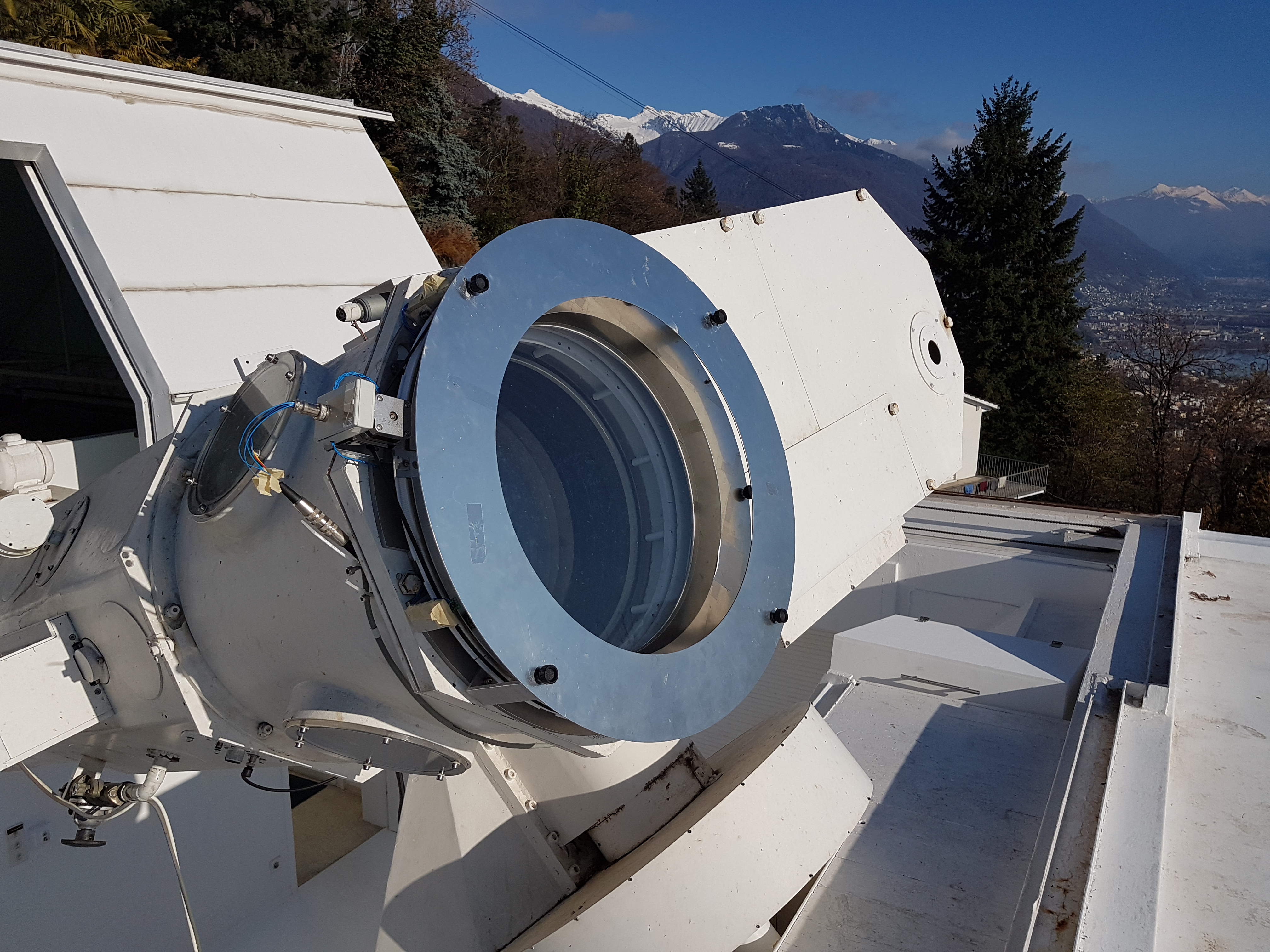Local seeing and instrumental effects make it difficult to determine the solar polarisation signals with high precision. IRSOL is developing a novel method that adds a slow modulation to the usual fast modulation of the incoming light to solve this problem. Such a technique could be implemented on EST.
 Telescope Calibration Unit mounted on the Gregory-Coudé telescope in Locarno (Switzerland). Credit: IRSOL
Telescope Calibration Unit mounted on the Gregory-Coudé telescope in Locarno (Switzerland). Credit: IRSOL
As we have seen in previous articles, polarimetry is the method used to characterise solar magnetic field. By measuring the polarisation of light, scientists can determine the orientation of the magnetic field with respect to the observer. However, polarisation is also a delicate measurement that needs very high precision.
“If you have a constant beam of light and you need to measure linear polarisation in one direction, things are easy”, points out Michele Bianda, from the Istituto Ricerche Solari Locarno (IRSOL). The method consists in setting a linear polariser in one direction and taking an image. Then you rotate the polariser by 90º, and take another image. The fraction of linear polarisation will be the result of subtracting the two images divided by their sum, that is, (Image 1 - Image 2)/(Image 1 + Image 2).
Problems begin when real observations are performed. For example, turbulence in the Earth's atmosphere creates spurious polarisation signals of the same amplitude or even larger than the signal coming from the Sun. To minimise this seeing-induced polarisation, there are two possibilities. The first one is to split the light into two beams, with a polarising beamsplitter, instead of rotating a single polariser. Then, measurements are made for the two beams simultaneously, and with a good telescope calibration, the formula (Image 1 - Image 2)/(Image 1 + Image 2) can still be applied. Both images are supposed to be influenced by the atmosphere in the same way, so the seeing-induced polarisation cancels out in the difference image. But a problem arises when the two beams follow different optical paths in the instrument. “Then we have to apply Murphy's law that all constants are variables”, jokes Bianda to highlight that it is neither an easy nor a perfect technique.
The other method is to modulate the light faster than the typical frequency of the atmospheric turbulence, so the images won't be affected by the atmosphere, as we explained in this article. The measurements have to be made at 1 kHz (1000 images per second) or faster. At such speeds, very few photons can be collected in a single image, and thus several images need to be accumulated to reduce the noise of the measurements.
High precision relative measurements
The Zürich Imaging Polarimeter (ZIMPOL) implements the fastest temporal modulation among all the solar polarimeters in operation today. ZIMPOL uses a special CCD, where every fourth row of pixels is free and the others are masked. The images on the detector are shifted from the exposed rows to the masked rows back and forth, in synchrony with the modulator, producing four images for four different modulation states. This is done at 1 kHz, to effectively freeze the Earth’s atmosphere. The images are read out after sufficient photons have been accumulated. By combining the four images one can determine the polarisation state of the light. This method delivers very sensitive measurements that can detect small changes in polarisation from one pixel to the next. In other words, the relative values of the polarisation signal are very precise.
 Schematic of the TCU concept. By combining slow and fast modulation the polarimetric precision is significantly increased. Credit: IRSOL
Schematic of the TCU concept. By combining slow and fast modulation the polarimetric precision is significantly increased. Credit: IRSOL
Achieving high precision absolute measurements
However, the absolute value of the polarisation signal is known with lower precision. Why? If fighting against the seeing wasn't enough, when the light travels inside the telescope new troubles arise. Mirrors, lenses, diffraction gratings…. they all introduce instrumental polarisation. These effects modify the solar signals, making the zero level of the polarisation scale difficult to set. To solve this problem, IRSOL has developed a Telescope Calibration Unit (TCU) which is based on a rotatable retarder film, set up in front of the IRSOL Gregory-Coudé telescope. The retarder rotates slowly (e.g. every 10 seconds) and changes the polarisation of the incoming light. However, the instrumental effects remain the same, so it is possible to quantify and remove them, determining the zero level of the polarisation scale with high precision.
In summary, this slow modulation makes it possible to correct for systematic instrumental polarisation signals induced by the telescope and post-focus instruments such as polarimetric offsets and cross-talk between polarisation states. The novelty consists in combining the TCU with the fast modulation carried out by polarimeters like ZIMPOL.
The technique has proved successful for a medium-size solar telescope like the Gregory-Coudé telescope at IRSOL. But, would it work in a larger telescope? In the framework of the SOLARNET project, researchers are testing the method at GREGOR. In this case, the idea is to place the retarder after the secondary mirror, not in front of the telescope, because the reflections on M1 and M2 are always normal and these barely introduce instrumental polarisation. If the results of the observations performed at GREGOR with this technique are better than those obtained previously, the next step will be to figure out how to implement it on EST.
For more information
- M. Collados, 1999, "High Resolution Spectropolarimetry and Magnetography", ASP Conference Series, 184, 3.
- "Designing a telescope free from instrumental polarization" (article in Technology of EST series)
- "Polarisation modulators for EST" (article in Technology of EST series)
